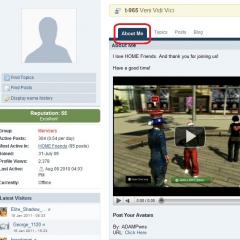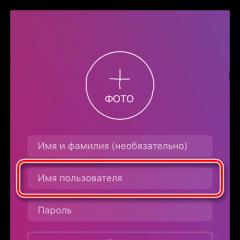Mpeg2 video is not supported. File extension MPEG2. Playing videos on slow computers
The latest version of the Windows 10 operating system has revealed the need to install an extension for the standard Movies and TV application from the Microsoft Store. When trying to open a video of an unsupported format using the standard playback application, the user receives a message that they need to install a video extension.
This article will tell you how to install the MPEG-2 video extension on Windows 10 version 1809. Since after the update, when trying to install the extension from the Store, the user received a message in the notification center: Failed to install the MPEG-2 video extension. We will try again soon.
The MPEG-2 extension helps video programs installed on Windows 10, such as Microsoft Movies & TV, to play MP4 or MKV video files. If you can't play videos with file name extensions such as: .mpeg, .mpg, .ts, .m2ts, .mkv and .avi, then this extension should also help you play them.
If, when you try to get an extension for MPEG-2 video from the Store, you get an error with code 0x80073D01 or the message: Failed to install the extension for MPEG-2 video. We will try again soon, then you should follow the following instructions. This error can be seen in the Windows 10 Action Center.
Installing the latest updates
First of all, we recommend going to the update center and checking for updates. Because every new update fixes old errors in the system. If you currently do not have the opportunity to install the latest updates, then you can.

The video extension must be installed on the system drive, we just need to change the location to a third-party drive, and then select the system drive again. Indeed, this error looks strange, since by default the system disk is set to download applications from the Microsoft Store, but it works.
It is enough to change the location in which applications are saved by default to make the error disappear: The MPEG-2 video extension could not be installed. We will try again soon.

In previous versions of the operating system, you had to go to Storage and press the button Change where new content is saved. In the current location, you must also select a third-party drive, and then change it to the drive with the system. If a third-party drive is installed by default, then just select the system drive.
This method will solve the problem with an error when installing the extension. But after selecting the second local drive as the standard path for installing new content, an empty folder will be created on this drive, which cannot be easily deleted. Therefore, see also what to do when writing
Note. If the video was recorded at a low frame rate (approximately 15 frames per second or lower), there will still be some juddering when playing back the video.
Note. Not all formats are available on Mac OS and Windows platforms. See the corresponding Help topics links above for more detailed information about which platforms are supported for each format.
Some video file formats - including AVI and MOV - are files - containers . Data inside container files is encoded according to the specified codec . Codecs are algorithms for compressing audio and video data. There are many different codecs.
For example, an AVI file can be encoded using the following types of codecs, among others:
- DV codec (this codec is used in camcorders that record videos on miniDV tape)
- Commercial codecs (eg DivX)
- Motion JPEG codec (this codec is used in some cameras that have video recording capabilities)
Sometimes Adobe Premiere Pro cannot decode video files that were encoded using a low-quality codec or a codec that is not installed on your computer.
Knowing the format and, if necessary, codec for the files you are working with will help when using the solutions below. To obtain this information, do one or more of the following:
- Open the file in Apple QuickTime Player and choose Window > Show Movie Inspector.
- If the file came from a camcorder, camera, or other video recording device, see the documentation for the device or refer to the device specifications on the manufacturer's website.
- Open the file in a third-party media analysis application, such as MediaInfo or GSpot 2.70
Codecs can be downloaded from third party websites.
Attention! Only download codecs from trusted, trusted software developers. Avoid downloading software with a codec pack. Installing a new one may make it impossible to play some video or audio files. Before you begin, make a backup copy of all files.
Because MPEG-2 files can be encoded with a wide variety of settings, not all imported MPEG-2 files will play smoothly in Adobe Premiere Pro CS4. Re-encode the problematic MPEG-2 files (see ), and then import them.
VOB files
VOB (video object) files used on DVDs are a type of MPEG-2 file. Adobe Premiere Pro CS4 (with all updates applied, select Help > Updates) and Adobe Premiere Pro CS5 and later support importing DVD-compatible VOB files. If you have problems importing the original VOB file, there may have been problems creating it. (For example, there might be a problem with your DVD ripping software.) You may need to re-encode the problematic VOB files (see ) and then import them.
If you are working with videos recorded on a camera, see its documentation. Or contact your camera manufacturer for details about the video files it can record.
If you are unable to import or play files from your camera, you may need to install a codec (see ). Most digital cameras encode video files using the Motion JPEG (MJPEG) codec. Motion JPEG (MJPEG) codecs are provided by several developers.
Note. The Motion JPEG codec uses relatively low levels of compression. Therefore, when working with large Motion JPEG video files in Adobe Premiere Pro, you may experience performance issues or receive low memory error messages. To resolve these issues, re-encode the Motion JPEG files (see Solution 4). For example, some Flip Video camcorders encode videos using the 3ivx codec. If your camcorder does not use a dedicated codec, transcode the files using the software that was included with your camcorder (if available). Or use other software (see) to transcode the video. Then import the recoded files.
If you are able to import files from a compact digital video camera, work in sequence with appropriate frame size, frame rate, and field settings. (See.) If you are using files from a digital video camera that records high-definition (720p) video, work in progressive sequence (borderless). If you are using files from a digital video camera that records interlaced video, the files may have a field order setting that processes the top fields first.
IPTV on your smartphone =)
Yes, video player http flow, and along UDP =)
UDP proxy MXplayer gave me an error saying " mpeg2video is not supported"!

Then go to the section " Decoders"

custom decoders

That's all the magic =)
VLC, he's an omnivore =)
Details Magnum 12/24/2017
Playback error "mpeg2video not supported"
This week I decided to play with IPTV! Try to run it on your smartphone =)
What is difficult to say here?! Yes, essentially nothing, the necessary software in the form of a program for working with playlists is there, a video player that supports this function is also present. There's just one thing, the video doesn't work http flow, and along UDP =)
After googling a little about how to get it up on the router, I decided to do it. Later, as it turned out, to raise UDP proxy I didn’t need it, but imagine my surprise when the player I liked, MXplayer, gave me an error saying “ mpeg2video is not supported"!

Then go to the section " Decoders"

We go down to the very bottom and in the section custom decoders point let to the received file

That's all the magic =)
You can, of course, not bother and just install VLC player, it’s omnivorous =)
But we are not looking for easy ways! So may the force be with you, young Jedi;)
Can't play videos on your Android smartphone or tablet using MX Player Android video player? There is a picture, but no sound or the subtitles are not displayed correctly? There is only one conclusion - your video player needs codecs that will ensure stable operation of the application. If earlier versions of the player had built-in programs, now codecs for MX Player Android must be installed separately. In this review we will collect links to the most necessary codecs for MX Player and MX Player Pro Android.
You will learn about the purpose and functions of codecs for MX Player Android, and you will also be able download codecs for Android 4.2 and other OS versions by clicking on the links located at the end of the article. In the meantime, a few words about the MX Player application itself for Android.
Why choose MX Player
Millions of users download MX Player Pro for Android because this video player:
- thanks to hardware decoding, supports a large number of video formats;
- operates on the basis of multi-core decoding, which improves performance;
- can increase and decrease the image size while watching a video when you drag your fingers across the display;
- has convenient management of subtitles, setting the text size and other parameters;
- At the same time, accidental launches of applications, etc. are excluded. while browsing thanks to the “smart lock” function.
Codecs (including for MX Player Pro Android) are special applications whose main purpose is to compress and play multimedia files. These processes are also called encoding and decoding, respectively, which is where the program gets its name
Why does MX Player Android need file encoding
Multimedia files are large in size, especially when it comes to video, which is why they are inconvenient to transfer over the network. Thanks to the use of codecs for MX Player Android, the file size is significantly reduced, but the encoding process does not have any effect on the quality.
If you encounter system errors when trying to play a video on a mobile device, then the installed player needs a suitable codec. It should be remembered that a codec without a video player is not effective - by itself it does not have the function of playing multimedia files. The purpose of the codec is to help MX Player.
Types of codecs
In order for MX Player Pro for Android to perform its functions, you need to install the correct codec. All applications are available on Google Play, the main thing is to choose the appropriate option. Codecs vary depending on the device's CPU architecture:
- ARMv7;
- ARMv7 Neon;
- Tegra 3;
- ARMv6 VFP;
- ARMv6;
- ARMv5;
All types of codecs for Android 4.2 and other versions have the same purpose - correct playback of multimedia files: audio and video.

How to install codecs on MX Video Player
- Launch MX Video Player on Android.
- Click on the button with the image of three dots and open the application settings.
- Go to the decoder section, scroll down the menu and find the column with basic settings.
- Find below the line “Custom codec” the name of the codec that is suitable for your device - this is the application you need to download.
- Find the application on Google Play and install it on your Android mobile device.
Remember: for correct operation, you must first download MX Player Pro for Android and only then install the required codec. The system will perform the rest of the actions on its own.

Codecs and modern smartphones
Even very ancient gadgets can play video in standard definition with codecs correctly selected for a specific hardware. If we talk about smartphones that were released in the last two or three years, the vast majority of them will not encounter problems playing video in HD resolution (720 p) if the necessary codecs are available.



